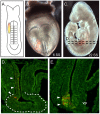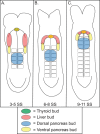A fate map of the murine pancreas buds reveals a multipotent ventral foregut organ progenitor
- PMID: 22815796
- PMCID: PMC3398925
- DOI: 10.1371/journal.pone.0040707
A fate map of the murine pancreas buds reveals a multipotent ventral foregut organ progenitor
Abstract
The definitive endoderm is the embryonic germ layer that gives rise to the budding endodermal organs including the thyroid, lung, liver and pancreas as well as the remainder of the gut tube. DiI fate mapping and whole embryo culture were used to determine the endodermal origin of the 9.5 days post coitum (dpc) dorsal and ventral pancreas buds. Our results demonstrate that the progenitors of each bud occupy distinct endodermal territories. Dorsal bud progenitors are located in the medial endoderm overlying somites 2-4 between the 2 and 11 somite stage (SS). The endoderm forming the ventral pancreas bud is found in 2 distinct regions. One territory originates from the left and right lateral endoderm caudal to the anterior intestinal portal by the 6 SS and the second domain is derived from the ventral midline of the endoderm lip (VMEL). Unlike the laterally located ventral foregut progenitors, the VMEL population harbors a multipotent progenitor that contributes to the thyroid bud, the rostral cap of the liver bud, ventral midline of the liver bud and the midline of the ventral pancreas bud in a temporally restricted manner. This data suggests that the midline of the 9.5 dpc thyroid, liver and ventral pancreas buds originates from the same progenitor population, demonstrating a developmental link between all three ventral foregut buds. Taken together, these data define the location of the dorsal and ventral pancreas progenitors in the prespecified endodermal sheet and should lead to insights into the inductive events required for pancreas specification.
Conflict of interest statement
Figures





References
-
- Tam PP, Khoo PL, Lewis SL, Bildsoe H, Wong N, et al. Sequential allocation and global pattern of movement of the definitive endoderm in the mouse embryo during gastrulation. Development. 2007;134:251–260. - PubMed
-
- Cardoso WV, Lu J. Regulation of early lung morphogenesis: questions, facts and controversies. Development. 2006;133:1611–1624. - PubMed
-
- Le Douarin N. An experimental analysis of liver development. Medical Biology. 1975;53:427–455. - PubMed
-
- Gualdi R, Bossard P, Zheng M, Hamada Y, Coleman JR, et al. Hepatic specification of the gut endoderm in vitro: cell signaling and transcriptional control. Genes Dev. 1996;10:1670–1682. - PubMed
-
- Deutsch G, Jung J, Zheng M, Lora J, Zaret KS. A bipotential precursor population for pancreas and liver within the embryonic endoderm. Development. 2001;128:871–881. - PubMed
Publication types
MeSH terms
Grants and funding
LinkOut - more resources
Full Text Sources
Other Literature Sources
Miscellaneous

